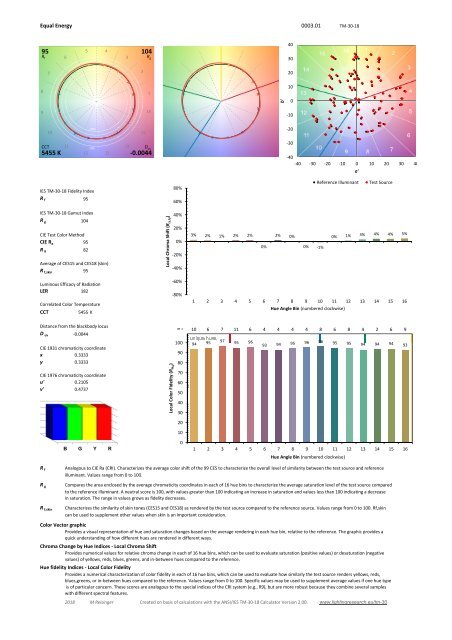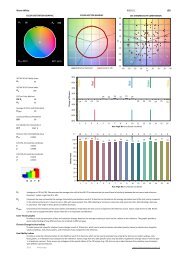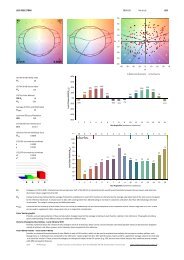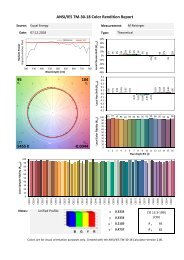IES TM-30 LED 3100K
Color vector graphics
Color vector graphics
Create successful ePaper yourself
Turn your PDF publications into a flip-book with our unique Google optimized e-Paper software.
Equal Energy 0003.01 <strong>TM</strong>-<strong>30</strong>-18<br />
95<br />
R f<br />
6<br />
5<br />
4<br />
3<br />
104<br />
R g<br />
40<br />
<strong>30</strong><br />
7<br />
2<br />
20<br />
8<br />
1<br />
b'<br />
10<br />
0<br />
9<br />
16<br />
-10<br />
-20%<br />
10 15<br />
-20<br />
CCT<br />
5455 K<br />
11<br />
20%<br />
12 13<br />
14 D<br />
CCT uv<br />
-0.0044<br />
-<strong>30</strong><br />
-40<br />
-40 -<strong>30</strong> -20 -10 0 10 20 <strong>30</strong> 40<br />
a'<br />
<strong>IES</strong> <strong>TM</strong>-<strong>30</strong>-18 Fidelity Index<br />
R f 95 R f 95<br />
80%<br />
60%<br />
Reference Illuminant<br />
Test Source<br />
<strong>IES</strong> <strong>TM</strong>-<strong>30</strong>-18 Gamut Index<br />
R g 104 R g 104<br />
CIE Test Color Method<br />
CIE R a 95<br />
R 9 82<br />
Average of CES15 and CES18 (skin)<br />
R f,skin 95<br />
Local Chroma Shift (R cs,hj )<br />
40%<br />
20%<br />
0%<br />
-20%<br />
-40%<br />
3% 2% 1% 2% 2%<br />
0%<br />
2% 0%<br />
0% -1%<br />
0% 1% 3% 4% 4% 5%<br />
Luminous Efficacy of Radiation<br />
LER 182<br />
Correlated Color Temperature<br />
CCT 5455 K 5460 CCT f<br />
-60%<br />
-80%<br />
1 2 3 4 5 6 7 8 9 10 11 12 13 14 15 16<br />
Hue Angle Bin (numbered clockwise)<br />
Distance from the blackbody locus<br />
D uv -0.0044 D uv -.0044<br />
CIE 1931 chromaticity coordinate<br />
x 0.3333<br />
y 0.3333<br />
CIE 1976 chromaticity coordinate<br />
u' 0.2105<br />
v' 0.4737<br />
B G Y R<br />
Local Color Fidelity (R fh,j )<br />
m =<br />
100<br />
90<br />
80<br />
70<br />
60<br />
50<br />
40<br />
<strong>30</strong><br />
20<br />
10<br />
0<br />
10 6 7 11 6 4 4 4 4 8 6 8 4 2 6 9<br />
94 95<br />
97 95 96<br />
93 94 95 96 96 95 95 94 94 94 93<br />
1 2 3 4 5 6 7 8 9 10 11 12 13 14 15 16<br />
Hue Angle Bin (numbered clockwise)<br />
R f<br />
R g<br />
R f,skin<br />
Analogous to CIE Ra (CRI). Characterizes the average color shift of the 99 CES to characterize the overall level of similarity between the test source and reference<br />
illuminant. Values range from 0 to 100.<br />
Compares the area enclosed by the average chromaticity coordinates in each of 16 hue bins to characterize the average saturation level of the test source compared<br />
to the reference illuminant. A neutral score is 100, with values greater than 100 indicating an increase in saturation and values less than 100 indicating a decrease<br />
in saturation. The range in values grows as fidelity decreases.<br />
Characterizes the similarity of skin tones (CES15 and CES18) as rendered by the test source compared to the reference source. Values range from 0 to 100. Rf,skin<br />
can be used to supplement other values when skin is an important consideration.<br />
Color Vector graphic<br />
Provides a visual representation of hue and saturation changes based on the average rendering in each hue bin, relative to the reference. The graphic provides a<br />
quick understanding of how different hues are rendered in different ways.<br />
Chroma Change by Hue Indices - Local Chroma Shi<br />
Provides numerical values for relative chroma change in each of 16 hue bins, which can be used to evaluate saturation (positive values) or desaturation (negative<br />
values) of yellows, reds, blues, greens, and in-between hues compared to the reference.<br />
Hue fidelity Indices - Local Color Fidelity<br />
Provides a numerical characterization of color fidelity in each of 16 hue bins, which can be used to evaluate how similarly the test source renders yellows, reds,<br />
blues,greens, or in-between hues compared to the reference. Values range from 0 to 100. Specific values may be used to supplement average values if one hue type<br />
is of particular concern. These scores are analogous to the special indices of the CRI system (e.g., R9), but are more robust because they combine several samples<br />
with different spectral features.<br />
2018 M Reisinger Created on basis of calculations with the ANSI/<strong>IES</strong> <strong>TM</strong>-<strong>30</strong>-18 Calculator Version 2.00. www.lightingresearch.eu/tm-<strong>30</strong>
















